North East Salinity Strategy Implementation (NESSI) Newsletter Autumn 2010 - Edition No. 42
Providing land management information to the community
Download the PDF version of this document: NESSI Newsletter - Autumn 2010 (PDF 310KB)
To view the information PDF requires the use of a PDF reader. This can be installed for free from the Adobe website (external link).
Inside this issue:  |
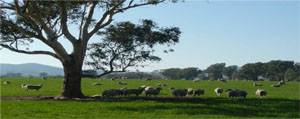 | Welcome to the autumn edition of NESSI. Over the last few months there have been a number of field days held for landholders across the catchment. Just in case you couldn’t attend, we have included some of the key messages from these events and where to go for more information on the topics covered. Also in this edition are the details for a number of upcoming events. Kylie Macreadie - Editor |
Erosion and flooding after Beechworth fire
Catchments affected by the Beechworth fire of February 2009 are still at risk of flash flooding and erosion during relatively small rainfall events. The removal of vegetation and destruction of ground litter has removed the cover that protects the soil surface and retains runoff. The burnt catchment will be at risk from erosion and flooding for some years to come. Experience after the 2003 and 2006 fires suggests, as a general rule, this risk may last for around five years.
The key message from these experiences is there may be an ongoing, increased potential for flooding to cause damage to fences, cause erosion and fill farm dams from sediment. Points to consider:
For more information on erosion contact Craig Turton, DPI Wangaratta on (03) 5723 8682 | 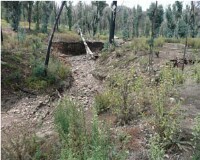 |
Around the catchment: Information and key messages about events and projects
| Highlights from spotlighting 'Creates of the Night' During September and December 2009, ‘Creatures of the Night’ spotlighting events were held around Chiltern. It was a great opportunity to see and learn about nocturnal animals that live along the narrow road reserves in our local area. The highlight for most people was seeing the endangered squirrel gliders feeding, climbing and gliding. From an untrained eye, squirrel gliders look like the more common sugar glider, except they are bigger and have a dense bushier tail. People also learnt about identifying different eye shine, noises and scratch and bite marks. Department of Sustainability and Department of Primary Industries hope to have another event over the coming months. These events are part of the Chiltern - Mt Pilot Biolink Project. For more information please contact Kate Hill, DSE Wodonga on (02) 6043 7926. | 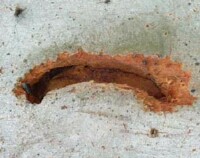 Picture: A glider bite mark found on a tree during the September 2009 spotlighting event. |
| Making the most out of organic wastes and manures Over 100 farmers and their advisors attended five workshops held across the North East and Goulburn Broken catchments in March. Participants travelled from a variety of areas to hear valuable information presented by Chris Dorahy of ‘ableblue’ on how to assess the characteristics, potential benefits and possible associated risks of manures, grape marc, biosolids, and organic wastes. Farmers and their advisors heard presentations and leant the requirements for assessing alternative fertilisers and soil conditioners and weighed up the roles these products could play in building resilient and sustainable farming systems, particularly in light of climate change. The Department of Primary Industries (DPI) in partnership with local Landcare groups, farming groups and councils where happy with the response from farmers. Some quotes gathered from landholders at the events included:
| |
| Platypus watch Platypuses are a unique Australian animal but often go unnoticed because they live such a secretive ifestyle. It’s a magic experience to see them in the wild, if you are lucky enough. Platypuses are very shy animals and will detect even the slightest noise or movement. The best way to increase your chances of observing one is by sitting quietly and scanning a creek, river or billabong during their busiest feeding time of the day, which is an hour before sunrise and an hour after sunset. The Corowa and Rutherglen Landcare groups have began a series of platypus surveys along areas of the Murray and Ovens River in conjunction with the Australian Platypus Conservancy. The surveys will provide a better indication of their existence in our local area because the official records for the local platypus are very poor. The first night along an anabranch of the Murray River unfortunately didn’t reveal any new sightings, but to our great delight the second survey night recorded one platypus and one water rat along Sunday Creek near Pfeiffer’s Winery at Wahgunyah. If you know of or have seen a platypus in your area please contact Kate Hill, DSE Wodonga on (02) 6043 7926 or alternatively you can lodge your sighting online by filling out an ‘Online Platypus Sighting Report’ at the Australian Platypus Conservancy website, by visiting http://www.platypus.asn.au/care/welcome.html (external link) | |
| Whole farm planning courses Learn about: principles of whole of property management, land classing and land degradation, understanding what type of soils you have and how to manage them, pastures and grazing management and lots more. A number of courses will be held over the next few months. To book your place please contact Mary Anderson DPI Wangaratta on (03) 5723 8655. Top | |
| Managing pastures for climate change project - field day summary The first Managing Pastures for Climate Change information day was held at Whorouly on Friday, February 26. The field day was organised by the Burgoigee Creek Landcare Group with FarmReady funding from the Federal Government. More than 200 landholders attended this event. The following is a summary with some of the key messages delivered by the speakers. Tim Ekberg, Project Coordinator: Presented the results of a recent review he had undertaken as part of the Managing Pastures for Climate Change project. Tim found phalaris pastures to be the best survivors. Australian phalaris, which has a flat growth habit, has persisted better than some of the newer more upright varieties and perennial pasture survival was best where there was higher soil fertility and where plants are rotationally grazed. Kate Sargeant, DPI Victoria: Spoke on pasture sowing. Kate demonstrated that it can take seven years to get your money back from sowing a new pasture. If that pasture fails after three or four years and it needs to be re-sown it would take 10-11 years to break-even on the investment, highlighting just how important it is to ‘get it right the first time’. Jim Virgona, Charles Sturt University, Wagga Wagga: Entertained the audience with his phalaris research. Jim conducted a survey of 61 paddocks on 34 farms in southern N.S.W. with rainfall above 550mm. The majority of the paddocks were sown with five species in the pasture mix. However, most of these paddocks only had two species remaining at reasonable densities after a few years. These species were phalaris and sub-clover. He concluded that ‘Shot-gun pasture mixes don’t work’. Tim McNamara, McNamara’s Country Store, Rutherglen: Focused on the latest ways to control weeds when sowing, or in existing, pastures. With regard to sowing he emphasised the importance of reducing weeds in the years prior to sowing a perennial pasture. Damien Carpenter and Andrew Walta, farmers: Spoke of their experience using forage rape (Greenland) and rye corn (Southern Green) to increase early winter feed. Both fodder crops are able to grow feed quickly on limited rainfall and the forage rape can be used as a break crop to reduce winter weeds e.g. barley grass. However both have their limitations. The forage rape is unsuitable as an entire diet for cattle, although it can be 100 per cent of a sheep’s diet and rye corn needs to be grazed hard, as it will tend to go to seed early. Geoff Millar, Department of Industry and Investment, NSW: Spoke about pasture cropping. The purpose of pasture cropping is to get a winter active plant (winter crop) growing in a summer active (C4) pasture. Since North East Victoria has predominantly winter growing pastures, there is limited opportunity to apply the principles in this winter rainfall environment. Although, those with summer active plants such as red grass and kangaroo grass could benefit from pasture cropping as long as there is enough nitrogen for the crop. John Mulvany, ONFARM Consulting: Pointed out that ‘Farm profitability is driven by the amount of dry matter grown and how well it is utilised’. If you want to maximise pasture growth and persistence, graze the plant when it is at the three or four leaf stage and then allow the plant time to regrow its leaves. John agreed with Jim Virgona, that allowing the plant to grow leaves after the autumn break will encourage persistence and allow you to grow more winter feed. This project will also have a number of demonstration sites. The farmer-managed sites will be set up in Murmungee - Whorouly, King Valley and Byawatha. Farm walks are planned throughout 2010 and 2011. For more information on perennial pasture management or events being organised please give Tim Ekberg a call on (03) 5727 3931 or email tim@farminganswers.com. Top | |
| Digging deep for healthy soils We all know healthy farm families are happy farm families. But how often do farmers get out and check the health of their soil, the foundation of productive crops and livestock? A new postcard has been developed by the DPI Healthy Soils project. The postcard aims to encourage land managers to ask key soil health questions and then seek answers online. The postcard poses a list of simple questions about soil testing, decision making, groundcover levels, treatment, investment and observations. Based on the answers, land managers can then work out if their soils need some soil health improvements. Advice on soil health issues and management can be found on the new soil health webpages on DPIs Victorian Resources Online (VRO) website. | 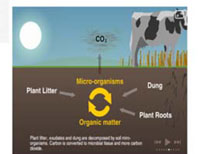 Picture: Example of the information included in the carbon cycle animation |
| Over 55 new pages were recently added to the website, there is a lot of information on a suite of topics. Topics on soil health include soil biology, organic matter, soil type, soil structure, nutrients, pH, erosion, compaction and crusting. There are also features such as a clip-on soil dispersion and a carbon cycle animation, which will be expanded on in coming months. The new pages allow users to search by subject, or to work through a series of questions, about things in their paddock that may be affecting soil health. The idea of the postcard and web pages is to encourage land managers to think about the health of their soils and to investigate ways to improve it. The VRO website can be found at www.dpi.vic.gov.au/vro/soilhealth. To obtain your copy of the postcard please contact either DPI Wodonga or Wangaratta. Article provided by DPI Healthy Soils project staff. Top | |
| Discover Black Swamp - Free event Learn all about the birds, frogs, aquatic bugs and plants that live at Black Swamp from a range of different speakers and local experts. When: Sunday 2nd May, 10:00am – 1:00pm Where: Black Swamp, Boorhaman East Road, 18 km south west of Rutherglen. BYO: Camera, gumboots, mosquito repellent, water bottle and sense of adventure. Lunch: Join us for a free BBQ lunch. RSVP: By Wednesday 28th April for catering purposes and for further information contact Sarah Daniell at the North East CMA, Wodonga, Phone: (02) 6043 7600. | |
| How salty is your water? It is important to know just how salty your bore, dam and creek water is so you can be aware of any effects on water use. During Saltwatch week, May 10 - 14, DPI is encouraging landholders to bring a water sample in to our Wodonga or Wangaratta office to be tested (locations listed on back page). Landholders are asked to bring in approximately one cup of water labelled with your name, phone number and the source of the water. The test only takes a few seconds. Saltwatch began in 1987 and is Australia's longest running community water monitoring program. Any schools interested in participating are encouraged to contact DPI, details below. For more information please contact Kylie Macreadie at DPI Wodonga on (02) 6043 7922 or Ian Gamble at DPI Wangaratta on (03) 5723 8671. | |
| Laugh it up .... tune it up - on May 24 at the Tallangatta Free Men's Health Night If you were a car, would you be a hot rod of a clapped out bomb? Do you check the oil pressure, spark plugs and general running of your car more than your own health? Towong Shire Community Support Committee in conjunction with many sponsors and partners are hosting a FREE Men’s Health Night PIT STOP event in Tallangatta on Monday, 24 May. Andrology Australia’s Ambassador Merv Hughes will be the after-dinner speaker on the night. Pit Stop for men is based on a mechanical concept of likening body parts to an engine. Pit Stop Assessments include checking oil levels (blood pressure), testing torsion (flexibility) and inspecting the duco (looking for skin cancer spots). Top |  |
| A similar free Men’s Health Night was held late last year in Wangaratta with 300 men attending. Excellent feedback resulted from that event. We encourage you to come along to the FREE Men’s Health Night starting at 5pm at the Tallangatta Memorial Hall on Monday, 24 May. Special arrangements are available for dairy farmers. Booking are absolutely essential. Please phone CentaCare by 14 May on 02 6051 1861 or email sarah.harrison@centacare-sandhurst.org.au and leave your name, phone number and details. Andrology Australia’s website (andrologyaustralia.org) has lots of free up-to-date information on Men’s Health. You can register for a free quarterly email or Australia Post delivered newsletter ‘Healthy Male’. | |
| New Courses The DPI Meat and Wool team will be holding two new courses in the Goulbourn Broken Catchment during April 2010. Courses in the future will be held in locations dependent on landholder expressions of interest. Practical Beef Marketing The Practical Beef Marketing course aims to increase producers understanding on beef marketing, consumer needs and modern management practices. The course maps a pathway for producers to develop their own marketing action plan to meet desired market specifications and ultimately profitability. Practical Beef Marketing is run over eight sessions and during this time participants will:
Whole Farm Grazing Strategies Whole Farm Grazing Strategies is a five session program designed for livestock producers to develop skills in grazing strategies and to develop a detailed plan which will help to achieve pasture and animal targets for different land classes, pasture type/species and stock classes for their individual properties. The course will include:
If you would like to find out more information on these two courses or express interest in attending future courses please contact Alison Desmond, DPI Benalla on (03) 5761 1643. Top | |
| Shelterbelts for varying climatic conditions Shelterbelts are vegetation barriers that reduce wind speed and provide shelter for stock. Providing shelterbelts allows animals to cope better in varying climatic conditions, especially in the extreme conditions that can be experienced in the north east Victoria. The primary benefit of providing stock with shelter from extreme weather conditions is to prevent stock loss. Stress on stock created by heat or cold can also impact on conception rates and mortality rates in young stock, impacting on the long term farm profitability. | 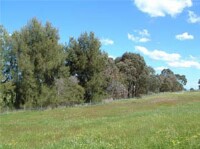 |
Shelterbelts can also provide a range of other production and environmental benefits for your property and local catchment:
Planning where to locate your shelterbelts, so they have multiple benefits is best identified through developing a whole farm plan. A whole farm plan allows you to identify the best location for shelterbelts whether it is to enhance existing assets such as patches of remnant bush or address threats such as soil erosion. Establishing shelterbelts will take time and money, so identifying the highest priority is to start establishing them is important. A good place to start might be to identify a paddock that can be used in extreme conditions and create a shelterbelt around it. This paddock might also be suitably placed for feeding stock and have a good water supply. When planning shelterbelts, thought should be given to the density, width and orientation, along with the species of plants and their growth patterns. More information on the design and benefits of shelterbelts, and whole farm planning, can be found in several DPI Information notes at www.dpi.vic.gov.au/notes or please contact Kylie Macreadie at DPI Wodonga on (02) 6043 7922. Top | |
| Protecting threatened grassy woodlands A new project which aims to protect threatened Box-Gum Grassy Woodlands and Buloke Woodlands in north east Victoria will have significant benefits for the environment. The two year project will protect more than 1200 hectares of threatened woodlands and raise community awareness of conservation issues. Through the project, eligible landowners will be assisted with funding to help protect woodlands through altered fencing, if needed, and management payments for controlled grazing and pest plant and animal works. | 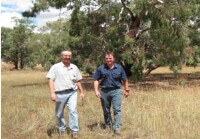 |
| To be assessed for eligibility, sites will need to be more than five hectares in size and support either of the threatened woodlands. A DSE field officer will visit nominated sites and determine eligibility. Box-Gum Grassy Woodland These woodlands typically occur on lower slopes and foothills of North East Victoria where the dominate trees species include White Box, Yellow Box or Blakley's Redgum, also known as Hill Red-gum. Areas of ‘derived grassland’ (native pasture) also occur throughout the catchment where the original woodland tree cover has been cleared. Many landholders will recognise these areas as unimproved land with native grasses. Project benefits Approximately 90 per cent of Box Gum Grassy Woodland has been cleared in the North East catchment. Much of what remains occurs on private land. This project will help secure important remnant sites on private land. Project focus areas The woodlands project is focussing on suitable native vegetation in the following general locations - Barnawartha, Chiltern, Indigo Valley, Wodonga, Bethanga, Granya, Talgarno, Walwa, Tallangatta, Byawatha, Springhurst, Everton, Whorouly, Greta, Wangaratta, Peechelba and Rutherglen. The project is supported by the North East CMA in collaboration with the Goulburn Broken and Murray CMAs, Australian National University, Trust for Nature and the Nature Conservation Trust NSW. It is funded by the Australian Government’s Caring for our Country program. For more information contact Matt Looby at DSE Wangaratta on (03) 5723 8673. | |
For information on land and biodiversity management contact any of the following DPI or DSE staff.
| Peter Ockenden, Team Leader | (03) 5723 8674 | Sarah Kelly, Biodiversity Officer | (03) 5723 8659 |
| Ian Gamble, CMO | (03) 5723 8671 | Mary Titcumb, Biodiversity Officer | (03) 6043 7956 |
| Kylie Macreadie, CMO | (02) 6043 7922 | Kate Hill, Biodiversity Officer | (02) 6043 7926 |
| Mary Anderson, CMO | (03) 5723 8655 | Matt Looby, Project Officer | (03) 5723 8673 |
| Craig Turton, CMO | (03) 5723 8682 | Phillippa Noble, Private Forestry | (03) 5723 8686 |
DPI/DSE Wangaratta Office 62-68 Ovens Street Wangaratta Phone: (03) 5723 8600 Fax: (03) 57214423 | DPI/DSE Wodonga Office 1 McKoy Street Wodonga Phone: (02) 6043 7900 Fax: (02) 6043 7910 | ||


